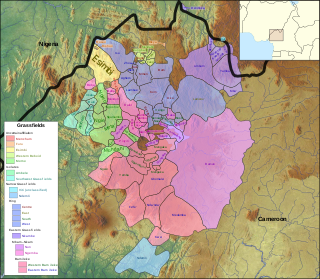
The Niger–Congo languages constitute one of the world's major language families and Africa's largest in terms of geographical area, number of speakers, and number of distinct languages. It is generally considered to be the world's largest language family in terms of distinct languages, ahead of Austronesian, although this is complicated by the ambiguity about what constitutes a distinct language; the number of named Niger–Congo languages listed by Ethnologue is 1,540.

Benue–Congo is a major subdivision of the Niger–Congo language family which covers most of Sub-Saharan Africa. It consists of two main branches:
Bikya is a potentially extinct Southern Bantoid language spoken in Cameroon. It is one of the three, or four, Furu languages. In 1986 four surviving speakers were identified, although only one spoke the language fluently.

Southern Bantoid, also known as Wide Bantu or Bin, is a branch of the Benue–Congo languages of the Niger–Congo language family. It consists of the Bantu languages along with several small branches and isolates of eastern Nigeria and west-central Cameroon. Since the Bantu languages are spoken across most of Sub-Saharan Africa, Southern Bantoid comprises 643 languages as counted by Ethnologue, though many of these are mutually intelligible.

Bantoid is a putative major division of the Benue–Congo branch of the Niger–Congo language family. It consists of the Mambiloid languages, the Dakoid languages and the Tikar language, all in Nigeria and Cameroon, and the Southern Bantoid languages, a major division which also includes the Bantu languages spoken across most of Sub-Saharan Africa.
Semi-Bantu or Semibantu are those African languages spoken by the inhabitants of the Western grassfields of Cameroon which are Bantoid languages, but don't belong to the Bantu languages.

The Beboid languages constitute a branch, or branches, of Southern Bantoid and are spoken principally in southwest Cameroon, although two languages are spoken over the border in Nigeria. The Eastern Beboid languages may be most closely related to the Tivoid and Momo groups, though Western Beboid, if it's a group at all, may be closer to Ekoid and Bantu.

The Grassfields languages are a branch of Benue–Congo spoken in the Western High Plateau of Cameroon and a sister group to the Bantu languages. Better known Grassfields languages include the Eastern Grassfields languages Bamun, Yamba and Bamileke and the Ring language Kom. The languages are closely related, sharing approximately half of their vocabulary.
Busuu is an unclassified Southern Bantoid language of Cameroon. R Breton noted in 1986 that there were just 8 speakers left, while as of 2005 there were 3 speakers of the language. Busuu is an endangered language.
Kemezung is a Southern Bantoid language of Cameroon. According to Ethnologue, it's 85% lexically similar to Bebe.
The Furu languages are a proposed group of poorly attested extinct or nearly extinct and otherwise unclassified Southern Bantoid languages of Cameroon. Suggested Furu languages are:
Naki, or Munkaf, is an Eastern Beboid language of Cameroon and Nigeria. There is no name for the language; it is known by the villages it is spoken in, including Naki and Mekaf (Munkaf) in Cameroon and Bukwen and Mashi in Nigeria, the latter listed as separate languages by Ethnologue, though they are not distinct.
Mungbam is a Southern Bantoid language of the Lower Fungom region of Cameroon. It is traditionally classified as a Western Beboid language, but the language family is disputed. Good et. al. uses a more accurate name, the 'Yemne-Kimbi group,' but proposes the term 'Beboid.'
Fang is a Southern Bantoid language of Cameroon. It is traditionally classified as a Western Beboid language, but that has not been demonstrated to be a valid family.
Mundabli is a Southern Bantoid language of Cameroon. It is traditionally classified as a Western Beboid language, but that has not been demonstrated to be a valid family.
Mbu’, or Ajumbu, is a Southern Bantoid language of Cameroon. It is traditionally classified as a Western Beboid language, but that has not been demonstrated to be a valid family. Inasmuch as Western Beboid may be valid, Mbu’ would appear to be the most divergent of its languages.
Saari, or Nsari, is an Eastern Beboid language of Cameroon. According to Ethnologue, it's 84% lexically similar to Ncane, making it very close to the Noni cluster.
Bebe, or Naami, is an Eastern Beboid language of Cameroon. According to Ethnologue, it's 85% lexically similar to Kemezung.
Cung (Chung) and Mboko are dialects of an Eastern Beboid language of Cameroon.
Northern Bantoid is a branch of the Bantoid languages of the Niger–Congo language family. It consists of the Mambiloid, Dakoid, and Tikar languages of eastern Nigeria and west-central Cameroon.






